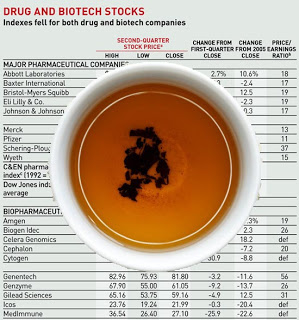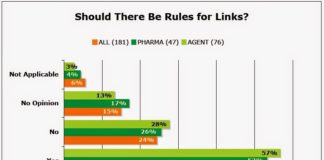 DDMAC’s (FDA) recently-released “Draft Guidance on Presenting Risk Information in Prescription Drug and Medical Device Promotion” (pdf file here) focuses almost exclusively on print and broadcast promotional ads. It mentions the Internet — where patients most often go first to find information on health (see, for example, “The Empowered Patient: What It Means for Pharma Marketers”; PMN Reprint #84-02) — only once by way of example, as in:
DDMAC’s (FDA) recently-released “Draft Guidance on Presenting Risk Information in Prescription Drug and Medical Device Promotion” (pdf file here) focuses almost exclusively on print and broadcast promotional ads. It mentions the Internet — where patients most often go first to find information on health (see, for example, “The Empowered Patient: What It Means for Pharma Marketers”; PMN Reprint #84-02) — only once by way of example, as in:
“Example 13: If a Web site for a product approved to treat high blood pressure presents information about a product’s benefits in postmenopausal women, any risks specific to postmenopausal women are particularly material.”
To illustrate how non-specific this is with regard to the Internet, all you have to do is substitute “Print ad” for “Web site.” Perhaps this is FDA’s way of saying that the same rules apply to the Internet as to print ads. I agree, but only so far as a Web page or display ad on the Internet is just another static piece of text/graphic. We used to call such Web sites “brochureware.”
Although the Internet has evolved to be much more interactive and user-generated, the FDA has evolved much less. We’ll have to wait for Obama-era appointees to work their way down the hierarchy at FDA before we see the FDA evolve more quickly. For now, this draft guidance, which was in the works for at least a year, will have to do.
The Internet may have evolved, but most of the drug advertising on it is pretty much the same as it was 5-10 years ago: static display search engine ads. Included in this category are the 70-character Google Adwords that were the subject of FDA’s recent 14 notices of violation. These notices cited the lack of adequate fair balance in search engine ads that mentioned the drug name and benefits; ie, they lacked side effect information.
I have always contended that these ads violated FDA regulations (see “Girl from Google“), but pharma marketers thought I was crazy (see “The ‘One-Click Rule’: Rant or No Rant?“) because, as every sane person knew, there was a “one-click rule” that allowed such ads as long as the risk information was just one click away (ie, on the landing page).
That’s water over the dam, so let’s move on.
It is quite easy to extrapolate from the current FDA draft guidance on presenting risk information in print ads to static Internet ads like Adwords. This may be like reading tea leaves, but since I have a good batting average when it comes to understanding the application of FDA regulations to Internet advertising, you just might want to listen to my POV. It could save you from a NOV letter down the road. And as Arnie Friede, counsel to the law firm McDermott Will & Emery LLP and former Senior Counsel at Pfizer, says, “every warning letter or notice of violation has another life–in a court of law” (see “Ramifications of FDA Regulatory Actions“; PMN Reprint #85-02).
I find the most relevant tea leaves on page 15 of DDMAC’s draft guidance. It’s under the section “Print Promotion.” Just think of an Adword or static banner or box ad as equivalent to a print piece. Yes, you can click on it and get more information, but the FDA probably considers the ad itself as the “main piece” and says:
“For a piece to be accurate and non-misleading, risk information should be included in the main part of a piece. If the omission of risk information in any part of a piece makes that part of the piece false or misleading, the problem cannot be corrected simply by including the risk information in a separate part of the piece [my emphasis]. To be comparably prominent to benefit information, risk information should generally appear in the same parts of the piece as the benefits.”
Now, you may not like that the FDA views an Adword as the “main piece” of a promotion, but there it is. I don’t think any argument about “reasonable man standard” is going to change DDMAC’s mind on this (see “Arnold Friede Blasts FDA’s Right to Define ‘Reasonable Man’ Without External Input“).
The draft guidance also states:
“As a general matter, risk and benefit information should be comparably noticeable or conspicuous in promotional pieces, and audiences should be able to read both risk and benefit information with similar ease [my emphasis].”
and
“Complete separation of benefit and risk information (e.g., presenting several pages of benefits before any risks) is one example of a lack of appropriate prominence.”
and
“Example 17: Risk information is placed in a thin column along the side of an ad in a different font and color scheme, so that the visuals and benefit information form a complete whole, separate from the risk information. This is not likely to be considered an adequate presentation of risk 582 information.” [Although this is about a print ad, it is easy to read the tea leaves here and extend the thinking to Internet display ads.]
I think no matter how you define a “reasonable man,” having to click a link in an Adword to get fair balance is not as easy as reading the benefits right there in front of you. Be honest, how often do you just read the first part of a news story in a newspaper without bothering to flip through to the page where it is continued? Even if you are reading the online version? I bet half of you have not even read this far into my post!
And, I’m also willing to bet that more than 95% of people (ie, “reasonable consumers”) who view Adwords do NOT click on them (if you have some secret sauce for increasing the clickthrough rates on Adwords, please let me know). Nevertheless, the ad has some value — building brand awareness as marketers say.
With regard to FDA’s view of a “reasonable man,” the following excerpt from the draft guidance document is relevant:
“Consumers have preconceived ideas about the amount of scrutiny these ads undergo. Many believe FDA exercises tight regulatory control over the content of these ads and to some extent, believe that all ads have been pre-reviewed prior to airing. As a result, consumers are likely to expect that the most relevant risks have been included in the ad.”
Imagine what a “reasonable consumer” would think if they saw a drug ad with NO risk information included in the main piece?
Be reasonable and read the DDMAC draft guidance at least through page 16.








![6 Digital Tools at the Center of Healthcare Digitalization [INFOGRAPHIC]](http://ec2-54-175-84-28.compute-1.amazonaws.com/pharma-mkting.com/wp-content/uploads/2021/04/6DigitalTools_600px-100x70.jpg)




